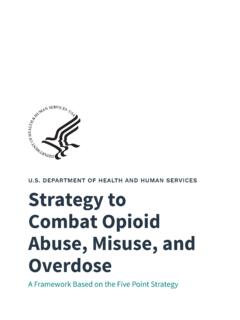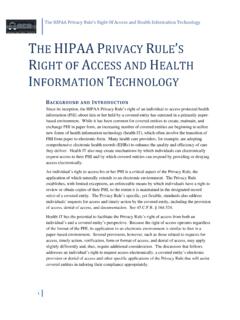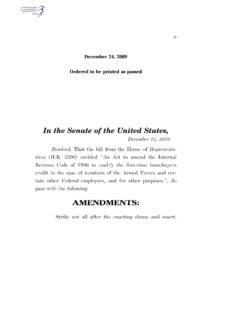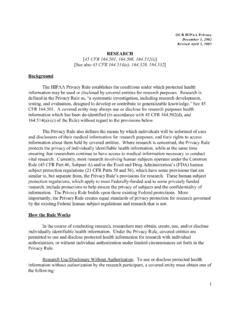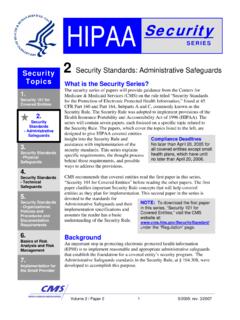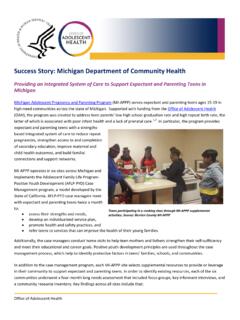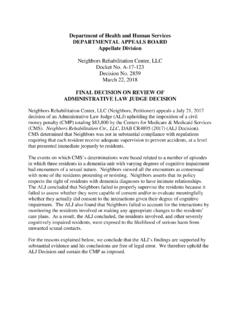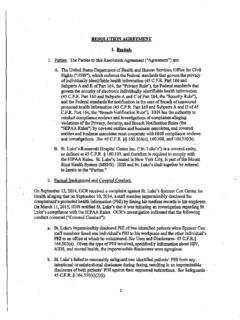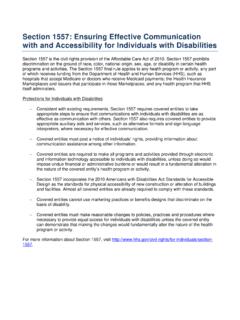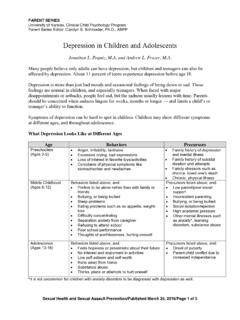Transcription of UAC Program Fact Sheet - HHS.gov
1 For Immediate Release February 17, 2022 Contact: ACF Press Office Phone: 202-401-9215 Email: fact Sheet Unaccompanied Children (UC) Program The Unaccompanied Children (UC) Program is managed by the Office of Refugee Resettlement (ORR) within the Administration for Children and Families (ACF), an operational division of the Department of Health and Human Services (HHS). Current Law - By law, HHS has custody and must provide care for each UC, defined as a child who has no lawful immigration status in the United States; has not attained 18 years of age; and, with respect to whom, there is no parent or legal guardian in the United States, or no parent or legal guardian in the United States available to provide care and physical custody. See 6 279(g)(2). Program Foundation - Under the Homeland Security Act of 2002, Congress transferred the care and custody of these minors to ORR from the former Immigration and Naturalization Service (INS) to move away from the adult detention model.
2 In the Trafficking Victims Protection Reauthorization Act of 2008 (TVPRA of 2008), which expanded and redefined HHS s statutory responsibilities, Congress directed that each child must be promptly placed in the least restrictive setting that is in the best interest of the child , subject to considerations of whether the child is a danger to self or others. See 8 1232(c)(2). Program Development - UC are referred to ORR by another federal agency, usually the Department of Homeland Security (DHS). Most children are placed into ORR care because they were apprehended by immigration authorities while trying to cross the border; others are referred after coming to the attention of immigration authorities at some point after crossing the border. HHS plays no role in the apprehension or initial detention of UC prior to their referral to HHS custody, and HHS is not a party to the child s immigration proceedings.
3 1 2 ORR has provided care for and found suitable sponsors for over 410,000 UC. For the first nine years of the UC Program at ORR, fewer than 8,000 children were served annually. Since Fiscal Year 2012 (October 1, 2011 September 30, 2012), this number has jumped dramatically, with a total of 13,625 children referred to ORR by the end of FY 2012. The Program received 24,668 UC referrals from DHS in FY 2013, 57,496 referrals in FY 2014, 33,726 referrals in FY 2015, 59,170 in FY 2016, 40,810 in FY 2017, 69,488 in FY 2019, and 15,381 in FY 2020. In FY 2021, DHS referred 122,731 UC to ORR. Because of the large fluctuations in arrival numbers throughout the year, ORR maintains a mix of standard beds that are available year-round, and temporary beds that can be added or reduced as needed.
4 This bed management strategy provides the ability to accommodate changing flows in UC referrals. In FY 2021, approximately 72% of all children referred were over 14 years of age, and 66% were boys. In FY 2021, countries of origin of youth in this Program were approximately as follows: Guatemala (47%); El Salvador (13%); Honduras (32%); and other (8%). As soon as children enter ORR care, they are put in contact with their parents, guardians or relatives, if known, and the process of finding a suitable sponsor begins. The vast majority of sponsors are a parent or a close family relative living in the United States. While ORR programs are looking for sponsors, children are provided age-appropriate care and wraparound services in one of the approximately 200 state-licensed facilities and programs in 22 states funded by ORR.
5 As of February 16, 2022, there are approximately 9,781 UC in HHS care. At the end of December 2021, the average length of UC care was 30 days. ORR is working to further reduce length of care in ways that do not jeopardize the safety or welfare of the children. The important work happening in each of the facilities and programs in the ORR network around the country work ORR has done successfully since 2003 takes an experienced team of competent, hardworking men and women dedicated to the welfare of the children. To comply with Congress directive to ensure the safety and suitability of potential sponsors for UC, sponsors are required to undergo background checks and complete a sponsor assessment process that identifies risk factors and other potential safety concerns.
6 Asa part of the unification process, potential sponsors must undergo a criminal public records check and in most cases, a sex offender registry check. When there is a safety concern for release to a related sponsor or when considering release to an unrelated sponsor, ORR also conducts background checks on adult household members and individuals identified in a potential sponsor s care plan. In addition, proposed UC sponsors who are not related to the UC, or proposed sponsors who are non-immediate family members ( not parents, siblings (including half-siblings), or grandparents) and who have never previously served as the UC s primary caregiver, must be fingerprinted as a safety 3 check. In addition, parents, step-parents, close relatives, and non-sponsor adult household members and adult caregivers identified in a sponsor care plan, could be subjected to fingerprinting under certain circumstances, such as when specific risks to the UC have been identified, the UC is particularly vulnerable, or a home study has been ordered.
7 The fingerprints are cross-checked with the Federal Bureau of Investigation s (FBI) National Criminal History Check, state repository records, and also includes a search of DHS arrest records. ORR will continue to perform public records checks on potential sponsors, and non- sponsor adult household members and adult caregivers identified in sponsor care plans when there is an identified safety concern, to ensure child safety. In some instances ORR also requires a home study before unifying a child with a sponsor. Home studies are mandatory under the TVPRA of 2008 for certain cases identified in law, including for: a child who is a victim of a severe form of trafficking in persons; a special needs child with a disability; where the child has been a victim of physical or sexual abuse under circumstances that indicate that the child s health or welfare has been significantly harmed or threatened; and where the child s sponsor clearly presents a risk of abuse , maltreatment, exploitation or trafficking, to the child based on all available objective evidence (see 8 1232(c)(3)(B)).
8 Additionally, per ORR policy, a home study is required for any child pending unification with a non-relative sponsor who is seeking to sponsor multiple children, or has previously sponsored or sought to sponsor a child and is seeking to sponsor additional children. ORR requires a home study for children who are 12 years and under before unification with a non-relative sponsor. Once unified with a sponsor, minors are expected to appear for any pending immigration proceedings, and since the beginning of the Program , ORR has notified Immigration and Customs Enforcement (ICE) at least 24 hours before and 24 hours after the unification of all UC with a sponsor. The notification includes the address of the UC, as well as the name of the sponsor. Program Services - Consistent with federal law, ORR places children while in our care in the least restrictive setting that is in the best interest of the child , taking into account potential flight risk and danger to self and others.
9 Presently, all ORR-funded state-licensed and influx care facility services include: Classroom education Mental and medical health services Case management Recreation 4 Unification services that facilitate safe and timely release to family members or other sponsors who can care for them. We conduct home studies prior to unification with a sponsor if safety is in question, and fund follow-up services for at-risk children after their release. Emergency Intake Sites (EIS) must provide basic standards of care to ensure the child s physical safety, access to legal services information, and access to emergency clinical services. Due to their emergency nature, EIS may not be able to provide a full range of services to UC but are encouraged to offer case management services, educational services, and recreational time for UC as practicable.
10 Program Responsibilities Making and implementing the best shelter placement decisions for the UC. Ensuring that the interests of the child are considered in decisions related to the care and custody of UC. Providing home assessments for certain categories of children Conducting post-release services for certain categories of children. Overseeing the infrastructure and personnel of ORR-funded care provider facilities. Conducting on-site monitoring visits of ORR-funded care provider facilities and ensuring compliance with ORR national care standards. Collecting, analyzing, and reporting statistical information on UC. Providing training to federal, state, and local officials who have substantive contact with UC. Developing procedures for age determinations and conducting these determinations Cooperating with the Department of Justice s Executive Office for Immigration Review to ensure that sponsors receive Legal Orientation Presentations for Custodians (LOPC).
